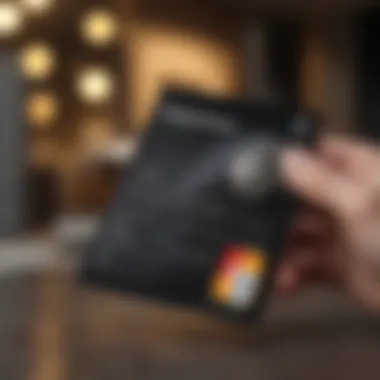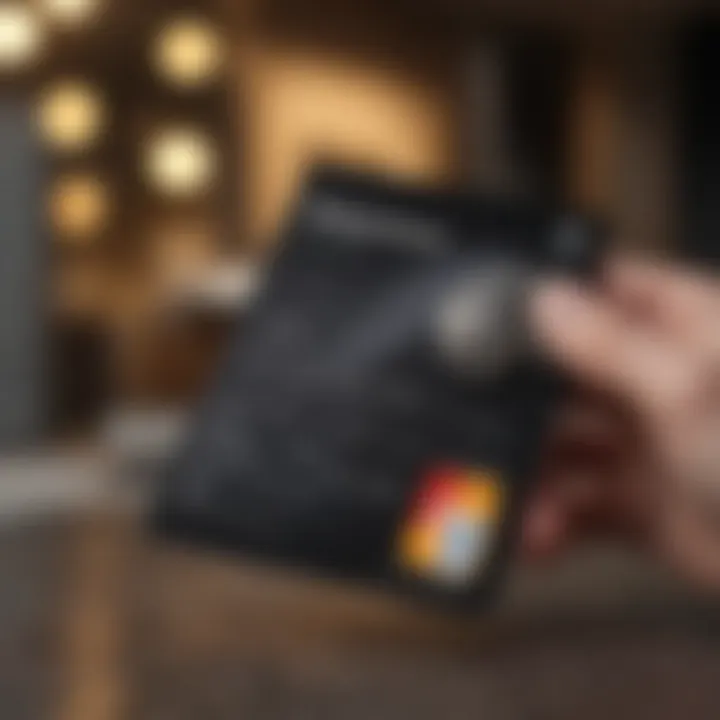Explore Prepaid Visa Cards Without Hidden Fees


Intro
Prepaid Visa cards have gained popularity among consumers seeking a financial tool that offers controlled spending without the complications of traditional credit cards. They provide an alternative for individuals looking to avoid debt accumulation while managing cash flow. This article delves into how to navigate the landscape of prepaid Visa cards without hidden fees, analyzing what options exist and how to make educated decisions regarding their use.
Understanding the essentials behind prepaid Visa cards is crucial. Often, these cards come with various benefits and drawbacks that influence their practicality for potential users. Moreover, knowing the factors that differentiate reliable vendors from those concealing hidden costs can enhance overall satisfaction with the chosen financial product. This guide serves to inform and empower consumers, ensuring they are well-equipped to select the right prepaid card for their needs, ultimately supporting better financial management.
Understanding Prepaid Visa Cards
Prepaid Visa cards have gained traction as a practical financial tool. This section is vital as it lays the foundation for understanding prepaid cards in the larger context of modern finance. Unlike traditional banking methods, prepaid cards offer a unique blend of flexibility and control for users, making them appealing for various consumer demographics.
As we navigate through this discussion, it becomes clear that understanding the functionality and implications of these cards can guide potential buyers in making informed selections. A deeper insight into prepaid Visa cards also addresses many common questions surrounding their usage, benefits, and limitations. Given the rapidly evolving landscape of payment methods, being well-informed leads to better financial decision-making.
Definition and Functionality
A prepaid Visa card is essentially a type of payment card that is preloaded with a specific amount of money. Users can only spend the amount loaded onto the card. This feature makes it distinct from credit or debit cards, which draw from a bank account or lend money up to a limit. Upon depletion of the balance, the card can no longer be used unless reloaded.
These cards serve various functionalities, including online purchases, in-store shopping, and even cash withdrawals at ATMs, depending on the terms set by the issuer. As a responsible alternative to cash, prepaid Visa cards do not require credit checks, which is beneficial for individuals attempting to establish or improve their credit scores.
Distinction from Credit and Debit Cards
Understanding how prepaid Visa cards differ from credit and debit cards is essential for prospective users.
- Credit Cards: These allow borrowing against a predefined credit limit; users are billed monthly for their spending. Interest adds complexity to the repayment terms, often leading to debt if not properly managed.
- Debit Cards: These directly link to a user's bank account, making transactions draw from existing funds without borrowing. Users must ensure that the account has sufficient funds; overdrawing can lead to fees.
In contrast, prepaid Visa cards operate on a pay-as-you-go basis. They do not require a bank account, making them accessible for those without traditional banking services. Users must manage their spending within the confines of the prepaid amount without the risk of accumulating debt.
The distinctions clarify that prepaid Visa cards cater effectively to certain financial needs, presenting a unique solution for individuals wanting to maintain strict control over their expenditures.
Advantages of Prepaid Visa Cards
The landscape of financial products is vast, yet prepaid Visa cards stand out due to distinct advantages they offer. Understanding these benefits is crucial for anyone considering their use. Prepaid Visa cards serve as a practical solution for controlling spending, managing budgets, and facilitating transactions without the dangers connected to credit card debt or overspending. Furthermore, these cards can be utilized by individuals from various financial backgrounds, making them an attractive option for a broad audience.
Financial Control
Prepaid Visa cards inherently grant users significant control over their finances. By loading a set amount of money onto the card, users can only spend what they have. This mechanism is particularly beneficial for individuals who struggle with overspending or managing credit. Unlike traditional credit or debit cards, there are no risks of incurring debt since the card cannot be used beyond the loaded amount.
Additionally, prepaid cards can assist in tracking expenses effectively. Most card providers offer online portals or mobile applications where users can monitor their spending patterns. Having a clear view of one's financial habits promotes better spending decisions and enhances the ability to save money.
Accessibility for All Users
Prepaid Visa cards are widely accessible, appealing to a diverse range of users including those with limited banking options. This includes individuals without traditional bank accounts or those looking to avoid the complexities associated with credit cards. Obtaining a prepaid card generally requires minimal documentation, making it easier for first-time borrowers or those with poor credit history to enter the financial ecosystem.
Moreover, these cards are often available at convenient retail locations and online platforms, allowing for easy acquisition. Users can reload their cards as needed, further enhancing their utility.
The flexibility of prepaid Visa cards is not limited to consumer convenience. Businesses can also utilize them for payroll or incentives, granting employees access to funds without requiring a bank account. This level of accessibility promotes financial inclusivity, bridging gaps for individuals who may otherwise be excluded from traditional banking frameworks.
"Prepaid cards provide a crucial entry point for those navigating the financial landscape, promoting responsible spending and accessibility."
Disadvantages to Consider
While prepaid Visa cards offer a flexible, convenient payment option, it is vital to consider their disadvantages. Understanding these drawbacks helps consumers make informed decisions. Here, we will delve into general limitations and potential fees associated with prepaid Visa cards.
General Limitations
Prepaid Visa cards, while beneficial in many ways, come with certain limitations that users should keep in mind. First, they do not contribute to building a credit history. Unlike credit cards, which can positively affect your credit score if managed well, prepaid cards do not report to credit bureaus. This can be a disadvantage for individuals looking to improve their credit score.
Second, prepaid cards can have spending limits. Depending on where you purchase the card or the provider, users might find that there are maximum amounts they can load or spend. This may not align well with everyone’s financial needs.
Lastly, some prepaid Visa cards might not be accepted everywhere. Although they function like regular debit or credit cards, some merchants may prefer traditional banking products. This could lead to frustrations if you attempt to use your card in such locations.
Potential Fees
One of the more commonly discussed aspects of prepaid Visa cards is the potential for fees. While cards that promise no fees do exist, consumers need to be vigilant. Here are several common fees that can catch users off-guard:


- Activation Fees: Some cards require an initial activation fee, which can eat into your starting balance.
- Monthly Maintenance Fees: Certain cards may charge a recurring monthly fee. This fee can significantly reduce the money you have available to spend.
- ATM Withdrawal Fees: Using an ATM outside the card’s bank network may lead to additional charges each time you need cash.
- Reload Fees: Adding funds to your prepaid card is often not free. Many vendors impose a fee when users load money onto their cards.
Finding Prepaid Visa Cards with No Fees
Finding prepaid Visa cards without fees is essential for anyone looking to manage their finances effectively. These cards serve as a viable alternative to conventional banking products, allowing users to make purchases without the constraints of credit or traditional debit cards. The absence of hidden fees can mean significant savings, especially for those who rely on these cards for everyday transactions. Users should remain vigilant, as some cards may advertise low initial fees but carry hidden charges that can add up over time. This section navigates the key elements involved in sourcing prepaid Visa cards that are free from unexpected costs.
Retail Locations
Purchasing prepaid Visa cards at retail locations can provide a straightforward solution for many consumers. Major retailers such as Walmart and CVS often have prepaid cards available. These retail outlets are beneficial for individuals who prefer cash transactions or instant purchasing.
When selecting a card from a retail location, it is crucial to inspect the card packaging closely. Look for any indications of fees associated with activation or maintenance. Some retailers offer cards with no activation fees as part of promotions, so it's a good idea to inquire about current offers.
Additionally, consider the availability of customer service if issues arise post-purchase. Retail locations may provide immediate assistance but knowing more about their support system can be advantageous.
Online Vendors
Online vendors offer a vast selection of prepaid Visa cards, often allowing for comparison of features right from the comfort of your home. Websites such as Green Dot and NetSpend allow users to choose from various prepaid cards tailored to different needs, such as budgeting or travel.
When buying a card online, it is essential to look at vendor reputation through customer reviews. Choose vendors that have received positive feedback regarding their service and card performance. Furthermore, confirm that the website is secure; check for SSL certificates and a clear privacy policy.
Many online vendors also provide special promotions, which might lead to free loading options or bonuses. Utilize these deals while remaining cognizant of any long-term fees that might apply.
Bank Affiliates
Some banks offer prepaid Visa cards that can be acquired either through branch locations or online platforms. Unlike general retail options, these cards often come with the backing of a well-established financial institution. This can enhance the security of your funds and provide easier access to customer service if issues arise.
When evaluating bank-affiliated prepaid cards, consider the following:
- Account Linking: Some banks allow you to link these prepaid cards with regular checking accounts, simplifying fund transfers without fees.
- Low Maintenance Fees: Many banks offer options that either have no monthly fees or minimal requirements to maintain a no-fee status. Reviewing these conditions before obtaining a card is critical.
Effective research into bank policies guarantees not only a prepaid Visa card without immediate fees but also ongoing cost savings in the long term.
Evaluating Vendors for Prepaid Cards
When considering the acquisition of prepaid Visa cards, evaluating the vendors becomes a paramount task. The decision significantly impacts your overall experience with the card, including usage costs, service quality, and the level of security provided. Keeping in mind that vendors vary greatly in terms of reputation and reliability, making an informed choice can save you from unexpected inconveniences later on. Vendors may come from different backgrounds, from retailers like Walmart and Walgreens to online platforms, and knowing how to evaluate them is essential to your financial safety and satisfaction.
Reputation and Reviews
Before selecting a vendor for your prepaid card, checking their reputation is critical. Start by looking at customer reviews on platforms like Reddit and Facebook. Customers often share their personal experiences, shedding light on various aspects such as customer service, card activation, ease of loading funds, and any hidden fees that may arise after purchase.
Several factors contribute to a vendor's reputation:
- Customer Feedback: Positive remarks highlight reliability, while negative reviews often reveal issues.
- Longevity in Market: Vendors that have been in business for a long time tend to be more trustworthy. Established companies usually have processes in place to handle customer concerns.
- Industry Recognition: Awards or certifications can reflect a vendor's commitment to quality.
Researching these aspects can make a big difference. It shows you not just what you can expect from the service, but it can also protect you from vendors that frequently frustrate customers.
Security Measures
In today's digital landscape, security is paramount when dealing with financial products, including prepaid Visa cards. Evaluating the security measures a vendor implements offers peace of mind. Key elements to consider include:
- Encryption Practices: The vendor's website should use HTTPS to ensure that data sent over the internet is encrypted.
- Fraud Monitoring Services: Vendors that actively monitor transactions for suspicious activities add an extra layer of protection.
- User Authentication: Multi-factor authentication is becoming more common, and it can safeguard your account from unauthorized access.
When selecting a vendor, look for detailed information regarding their security protocols. A trustworthy vendor should be open about it and provide clear resources regarding any protective measures they offer.
"Choosing vendors with strong security measures is not just about protection for your funds; it's about safeguarding your financial data from potential breaches."
Documentation and Requirements
When acquiring a prepaid Visa card, understanding the documentation and requirements is essential. This knowledge helps ensure a smooth and hassle-free process. Meeting the requirements means that users can confidently navigate the landscape of prepaid cards without encountering unnecessary issues.
One key element in this process is identification. Financial institutions and vendors often require proof of identity before issuing a prepaid card. This step helps them comply with regulations designed to prevent fraud and abuse. Generally, a government-issued photo ID, such as a passport or driver’s license, is necessary. Some retailers might ask for additional information, such as a Social Security number, to verify the identity of the applicant. Keeping this information handy makes acquiring a card more straightforward.
Identification Needs


The requirements for identification can vary by provider, yet they remain fundamentally similar across most vendors. To obtain a prepaid Visa card, users typically need to present a document that proves their identity. This could be:
- Driver’s license
- State ID card
- Passport
- Military ID
Additionally, some providers may request a secondary form of identification, for example, a utility bill or bank statement that includes the user's name and address. This document serves to confirm residency and further verify identity. Ensuring compliance with these requirements helps avoid potential roadblocks during the card application process.
Fund Sourcing
Another significant requirement involves funding the prepaid card. Users must know where the money for the card will come from. Most prepaid Visa cards allow for various funding methods, giving users flexibility in how they load money onto their cards. Common funding sources can include:
- Bank transfers
- Direct deposits
- Cash load at retail stores
Users should confirm beforehand which methods are accepted by their chosen card vendor. Understanding these funding options allows users to select the method that best fits their lifestyle and financial habits. This knowledge can also help identify limitations, such as minimum or maximum loading amounts, which differ across various vendors.
Loading Funds onto Prepaid Visa Cards
Loading funds onto prepaid Visa cards is essential for their functionality. These cards are not like traditional debit or credit cards that draw from a bank account or allow borrowing. Instead, they rely on preloaded funds that dictate the card's spending limit. This method provides a straightforward yet effective way to manage money without incurring debt, making it an attractive option for many, especially those looking to maintain strict financial control.
Methods of Loading
There are various methods for loading funds onto prepaid Visa cards, each with its own advantages. The most common methods include:
- Direct Deposit: Many prepaid Visa cards allow users to set up direct deposit from their paychecks or government benefits. This method is convenient, as it ensures funds are loaded onto the card automatically without any action required from the cardholder.
- Bank Transfers: Users can transfer funds from their bank accounts directly to their prepaid Visa card. This method typically requires linking the card with the user's bank account which often involves some initial verification process.
- Cash Reload: Many retailers and gas stations offer cash reload services. Users can go to the counter, present their card, and pay the desired amount in cash. This is a useful option for those who prefer handling cash.
- MoneyPak and Similar Services: Some services like Green Dot MoneyPak enable users to add funds to their prepaid cards. Users purchase a MoneyPak and load it onto their prepaid card through the card issuer's website or app. This method allows flexibility as it can be done online or through physical locations.
Choosing the right loading method depends on personal preference, convenience, and the fees associated if any. Always check for any charges before deciding on the method.
Value Limits
Understanding the value limits on prepaid Visa cards is crucial. Each card can have different limitations regarding how much money can be loaded or how much can be used in transactions. Common considerations include:
- Initial Load Limit: Some cards have a limit on how much can be loaded initially. This might range from a few hundred to a few thousand dollars.
- Daily and Monthly Load Limits: There may be restrictions on how much can be loaded daily or monthly, which can vary by provider. This could impact users who plan to load large sums.
- Spending Limits: Apart from loading limits, prepaid Visa cards often come with a cap on how much can be spent per transaction or within a certain period (daily, weekly, or monthly).
This ensures users do not overspend, reinforcing the financial control that prepaid cards are designed to provide.
Ultimately, understanding these limits helps potential users make informed decisions about which card meets their needs. Monitoring these parameters can prevent any unpleasant surprises during loading or spending.
Also, it is advisable to review each card’s terms and conditions regarding loading funds.
This level of diligence ensures users maximize the benefits of their prepaid Visa card.
Using Prepaid Visa Cards Wisely
Using prepaid Visa cards wisely is fundamental for users looking to manage their finances effectively. These cards offer flexibility and convenience, yet they come with responsibilities. Understanding how to employ these cards prudently can prevent overspending and enable users to maintain control over their finances.
Tracking Spending
Tracking spending is a critical practice for anyone using a prepaid Visa card. When users are conscious of their expenditures, they can quickly identify any unnecessary purchases that may affect their budget. Many prepaid cards provide online account management tools, allowing users to view transactions in real-time. This feature helps users categorize their spending, giving insight into where money is going each month.
Some effective strategies include:
- Regularly checking your account balance.
- Using budgeting apps compatible with prepaid cards.
- Noting down expenses as they occur.
Tracking spending not only enhances financial awareness but also aids in achieving financial goals. By keeping tabs on expenditures, users can make adjustments before it's too late, avoiding debt that often accompanies overspending.
Setting Budgets
Setting budgets is essential for a responsible use of prepaid Visa cards. It necessitates planning ahead and establishing spending limits in different categories, such as groceries, entertainment, and transportation. By distributing a fixed amount across these categories, users can better manage their funds.
A clear budget serves several purposes:
- It provides a framework for spending.
- It highlights areas where savings can occur.
- It encourages users to prioritize essential expenses over wants.
To effectively set a budget, consider these steps:


- Assess monthly income and necessary expenses.
- Allocate funds to categories based on priorities.
- Track spending against the budget throughout the month.
Regularly revisiting and adjusting the budget will ensure it remains relevant to changing financial circumstances. This proactive approach to budgeting takes full advantage of using prepaid Visa cards, thus maximizing their potential as financial tools.
Safety Concerns with Prepaid Cards
The landscape of prepaid Visa cards presents various benefits, but it is also essential to address safety concerns associated with their use. Understanding these concerns is crucial for consumers aiming to protect their funds and personal information. These cards often serve people who seek financial management tools without the complexities of traditional banking. Therefore, knowledge about security risks and measures is vital for all users, especially financial novices and first-time borrowers.
Fraud Prevention
Prepaid cards can be appealing targets for fraudsters. Users should be aware of common fraud schemes. For instance, identity theft can occur when personal information is compromised. Protecting your card requires several proactive steps:
- Use secure vendors: Ideally shop from recognized and reputable sources to ensure that the cards are valid and free from tampering.
- Monitor transactions: Regularly check your account statements to spot any unauthorized transactions promptly.
- Keep information private: Never disclose your card number or PIN to anyone, and avoid untrustworthy websites to prevent phishing attacks.
Taking these precautions can significantly diminish the risk of becoming a victim.
Federal Protections
Consumers using prepaid Visa cards do benefit from certain federal protections. These regulations provide a layer of safety, ensuring a level of security for users:
- Regulation E: This regulation offers rights to prepaid card holders. It provides protections against unauthorized transactions and mandates that card issuers have measures in place for reporting fraud. Users have a limited liability for any unauthorized activity, typically capped at $50 if they report issues promptly.
- Cardholder agreements: Understanding the specific protections provided in your cardholder agreement is key. Many cards now include provisions similar to those found with traditional bank accounts.
In summary, while prepaid Visa cards offer convenience and flexibility, it remains essential for users to stay vigilant regarding safety measures to protect their financial identities and funds. Understanding fraud prevention techniques and familiarizing oneself with federal protections can help users navigate the landscape safely.
Customer Service for Prepaid Accounts
Customer service plays a crucial role in managing prepaid Visa accounts. This aspect can significantly influence the user experience, especially for those who are new to financial products or may face challenges in navigating their accounts. Effective customer service provides necessary support, helping users resolve issues, access funds, and manage their prepaid cards efficiently.
A responsive customer service department can improve user satisfaction and build trust in the card issuer. With prepaid cards, users often encounter various questions or concerns, such as transaction disputes, balance inquiries, or issues related to loading funds. Having reliable support means that users can access the assistance they need in a timely manner, which is essential when dealing with finances.
Assessing Support Options
When evaluating customer service for prepaid accounts, several factors should be considered. First, check how easy it is to contact customer support. Are there multiple channels available, such as phone, email, and live chat? Prepaid card issuers that offer several means of communication are generally more accessible to users.
Second, look for customer service reviews. Websites like Reddit and Facebook often feature real-world user experiences that can indicate the quality of support. Positive feedback can indicate reliability. On the other hand, excessive complaints may raise red flags about the issuer's commitment to service.
Furthermore, consider the hours of operation. Some issuers may provide round-the-clock service while others may operate only during standard business hours. Users who frequently utilize their prepaid cards are likely to appreciate extended hours to address concerns.
Resolving Issues
Problem resolution is one of the most significant aspects of customer service for prepaid accounts. Issues such as lost or stolen cards, unauthorized transactions, and difficulties in loading funds can arise. When these situations occur, prompt resolution is vital.
» It is beneficial for users to understand the steps involved in resolving common issues.
- Start by collecting all relevant information regarding the issue. This can include transaction details, account numbers, and any previous communication with customer service.
- Reach out to support through preferred channels, such as a phone call or email. Clearly explain the problem to allow them to assist you efficiently.
- Follow up if the problem does not get resolved in a timely manner.
Ultimately, comprehensive customer service can significantly enhance the overall experience with prepaid Visa cards. By taking the time to assess support options and knowing how to resolve issues, users can navigate their prepaid accounts more confidently and effectively.
Epilogue and Recommendations
The conclusion and recommendations section plays a crucial role in summarizing the insights gleaned throughout this article about prepaid Visa cards. Here, it is essential to synthesize the information presented earlier, highlighting important aspects such as fees, vendor reliability, and consumer guidance. This section ultimately aims to empower readers with the knowledge needed to make informed financial decisions.
In choosing a prepaid Visa card, understanding the nuances can significantly impact financial habits. Key considerations include selecting cards free from hidden fees, evaluating customer service offerings, and comprehending the methods for loading funds. By placing emphasis on these elements, users can avoid pitfalls associated with prepaid cards, such as excessive charges or limited support options.
"A good prepaid card should not only serve as a financial tool but also come with reliability and transparency."
In essence, consumers should look for value in both the product itself and the vendor. A deep understanding of how prepaid cards function can lead to better choices, resulting in more control over spending and financial management.
Final Thoughts on Prepaid Visa Cards
Prepaid Visa cards can be an excellent financial resource, especially for those new to managing spending or without traditional banking options. These cards provide a straightforward way to control finances without the risk of overspending. They can benefit various groups, including students, travelers, and those seeking to improve credit history. The emphasis on finding cards without fees enhances their attractiveness as a budgeting tool.
However, potential users should remain vigilant regarding terms and conditions. Paying attention to the fine print enables individuals to identify any potential pitfalls before committing to a specific card.
Next Steps for Interested Buyers
For those interested in acquiring a prepaid Visa card, several steps can be taken to ensure a positive experience:
- Research Available Options: Look for reputable vendors known for transparency and customer service. Websites like Reddit and review platforms can provide insight into user experiences.
- Compare Card Features: Evaluate cards based on fees, loading options, and accessibility. Some cards may offer online management tools or mobile apps for enhanced tracking.
- Check Local Retailers: Many supermarkets and pharmacies offer prepaid Visa cards. Visiting in person allows you to ask questions directly and clarify any concerns regarding fees.
- Review Frequently Asked Questions: Most leading card providers have sections dedicated to FAQs. This can assist you in understanding specific terms and operational features.
By following these steps, buyers can confidently navigate the landscape of prepaid Visa cards, ensuring they make choices aligned with their financial needs.







